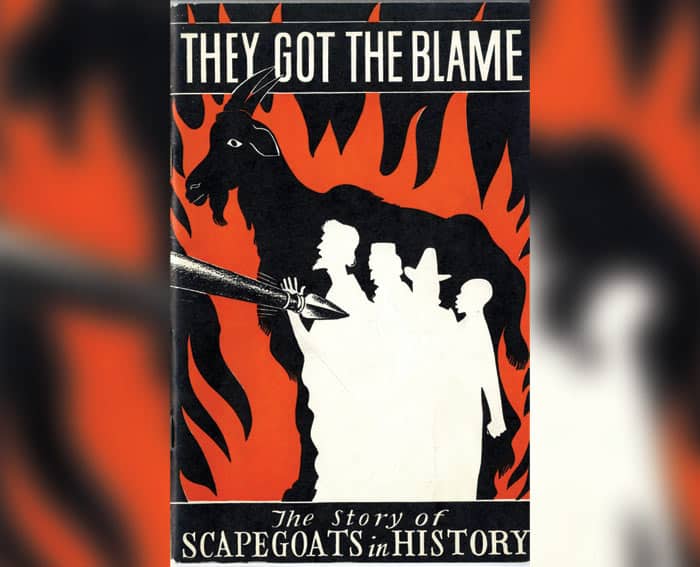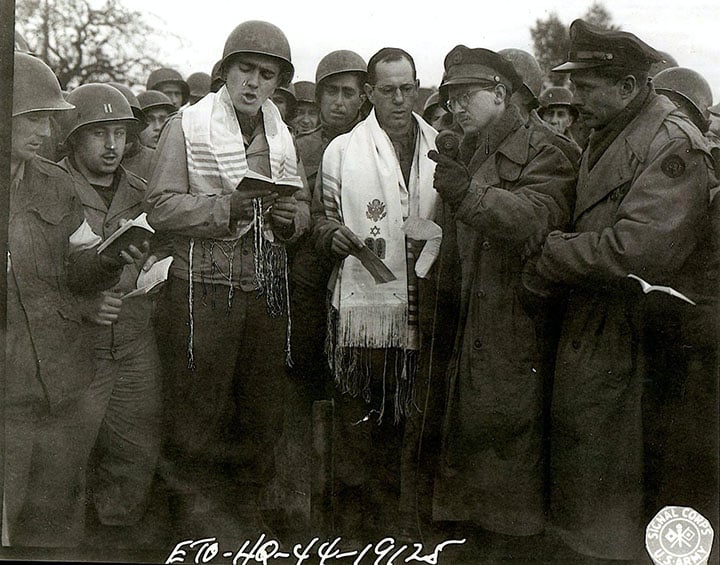
Since I started writing about antisemitism about a decade ago, I’ve had trouble answering one question: Why are Jews, who excel in fields from literature to music, so bad at confronting lies and hate?
Part of the answer of course is that antisemitism is irrational — based on conspiracy theories that morph every century. It’s also sadly the case that many Jews today in a position to create change — professors, heads of nonprofits, CEOs — would much rather suppress their Jewish identity to maintain their social “status.”
But neither fully explains how, for instance, the lies of “Palestinianism” have been able to completely consume our campuses. A small exhibition at the New-York Historical Society shows that this was not always the case.
“Confronting Hate 1937-1952” examines how a groundbreaking media campaign launched by the American Jewish Committee (AJC) to combat rising antisemitism in the United States actually worked.
“Confronting Hate 1937-1952” examines how a groundbreaking media campaign launched by the American Jewish Committee (AJC) to combat rising antisemitism in the United States actually worked. AJC CEO David Harris calls it “a testament to the vision of creative individuals committed to preserving and strengthening our pluralistic democracy.”
 American antisemitism didn’t begin in the mid-20th century, but it did reach a dangerous peak. In 1935, a newspaper called American Gentile featured on its front page: “Let’s Take America Away From the Jews!” and “Jewish CARTHAGE Must Be Destroyed if Free America Is To Survive!” By 1937, roughly 50 demonstrations a week, including rallies at Madison Square Garden, spewed antisemitic propaganda on the streets of New York City, inciting violence. Organizations such as the Anti-Jewish League to Protect American Rights and the American National Party distributed leaflets with slogans like “White Men Do Not Buy From Jews” and “Buy Gentile, Employ Gentile, Vote Gentile.” One 1938 survey found that nearly 41% of Americans thought that Jews were too powerful.
American antisemitism didn’t begin in the mid-20th century, but it did reach a dangerous peak. In 1935, a newspaper called American Gentile featured on its front page: “Let’s Take America Away From the Jews!” and “Jewish CARTHAGE Must Be Destroyed if Free America Is To Survive!” By 1937, roughly 50 demonstrations a week, including rallies at Madison Square Garden, spewed antisemitic propaganda on the streets of New York City, inciting violence. Organizations such as the Anti-Jewish League to Protect American Rights and the American National Party distributed leaflets with slogans like “White Men Do Not Buy From Jews” and “Buy Gentile, Employ Gentile, Vote Gentile.” One 1938 survey found that nearly 41% of Americans thought that Jews were too powerful.
The campaign partnered with dozens of artists, writers, political leaders, women’s and church groups, and celebrities to spread anti-hate messages across the U.S. in innovative ways.
The AJC campaign, spearheaded by advertising executive Richard Rothschild, partnered with dozens of artists, writers, political leaders, women’s and church groups and celebrities (including Frank Sinatra and Judy Garland) to spread anti-hate messages across the U.S. in innovative ways. Rothschild produced graphic posters, newspaper ads, and pamphlets, as well as comic books such as “They Got the Blame,” which chronicled the history of scapegoating. 
Nazism, Rothschild said in a 1973 interview, sought to spread internal discord. “Divisiveness can be the source of a country’s greatest weakness,” he said. His goal: to show the evil of antisemitism while also showing the importance of unity. “It would not be enough to show that antisemitism was bad for Jews,” he said. “We had to show that it was bad for America and Americans.”
For the first six years of the project, the AJC did not use its name. That changed after the Warsaw Ghetto Uprising in 1943.
The centerpiece of the exhibition is a short documentary about an extraordinary 15-minute radio broadcast on Sunday, October 29, 1944. “Today, the National Broadcasting Company brings its listeners a program of historic moment,” war correspondent James Cassidy began the show. “The first direct broadcast of a Jewish religious service from German soil since Adolf Hitler and his Nazis began the destruction not only of the Jewish religion but of all religions, more than a decade ago.”
The service, produced by the AJC and its radio director Milton Krents, took place in an open field near the site of a demolished synagogue in Aachen, Germany. With the sound of artillery rounds thundering in the background, we hear the haunting audio from Army Chaplain Sidney Lefkowitz, a rabbi from Richmond, Virginia, who led the service in front of 51 Jewish soldiers; a young private served as the cantor.
In a short address, Chaplain Lefkowitz acknowledged what the service represented. “Even as we sadly observe the ruins amid we stand and consider the loss of lives with which this victory has been purchased, we are solaced with the thought, though the cost must be high, of the lasting memorial which consecrates the sacrifice, and upon it is written in letters that glow like burning coals, ‘The spirit of man cannot be conquered.’”
The service, broadcast throughout Germany, was meant as a warning. “The Allied armies, composed of every color, faith, and nationality, will never halt until freedom takes the place of tyranny on every inch of Axis soil,” said Krents. But it also immediately captured the attention of Americans; the response was so profound that it was later re-aired. “The Aachen broadcast is a vivid reminder of the spirit and resilience of American GIs as they fought to eradicate Nazism,” said curator Debra Schmidt Bach. “Milton Krents understood the symbolism and importance of the service, and we are fortunate that he left us this poignant legacy and vivid example of the power of American cooperation.”
Forgotten in the decades after the war, the service at Aachen is only available to us now because of a chance discovery by AJC archive director Charlotte Bonelli, who noticed a brief mention of it in a Krents oral history in the mid-2000s.
The lessons of the AJC campaign are extremely valuable. American Jews need to start using our creative brains to fight the demons now descending on three fronts (Islamists, white supremacists, and “Black Hebrew Israelites”), as rapper Kosha Dillz did with “Death Con 3.”
Just as important, the overall focus needs to be on unity — on the beautiful mosaic of immigrants that America once stood for. But you can’t have that mosaic if there’s an over-emphasis on race — from either real racists or “anti-racists.” Woke ideology is meant to create division — precisely the type of division that leads to increased antisemitism.
The soldiers who attended the service at Aachen had survived Omaha Beach, one of the bloodiest sites of the Normandy invasion, and later fought in the brutal Battle of Saint-Lô in France. “These are men who belonged to a group of people that had been deemed by the Nazis to be cowardly — that they should be exterminated from the earth,” says Bonelli. “They’re standing on German soil, singing ancient Jewish prayers, equal members of the Allied advancing forces. It was a symbol that the war was coming to an end, and that Judaism and the Jewish people would survive.”
It is precisely this type of symbolism, innovatively updated for the 21st century, that needs to become a fixture on every U.S. campus.
Karen Lehrman Bloch is editor in chief of White Rose Magazine.





















 More news and opinions than at a Shabbat dinner, right in your inbox.
More news and opinions than at a Shabbat dinner, right in your inbox.